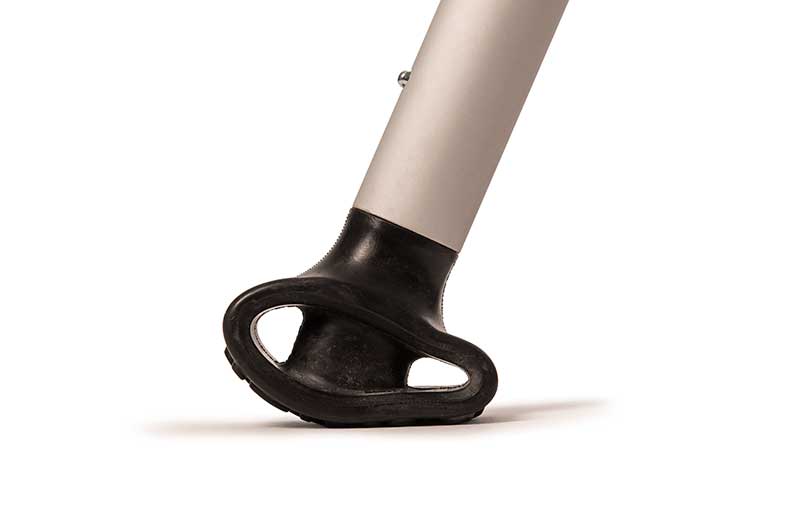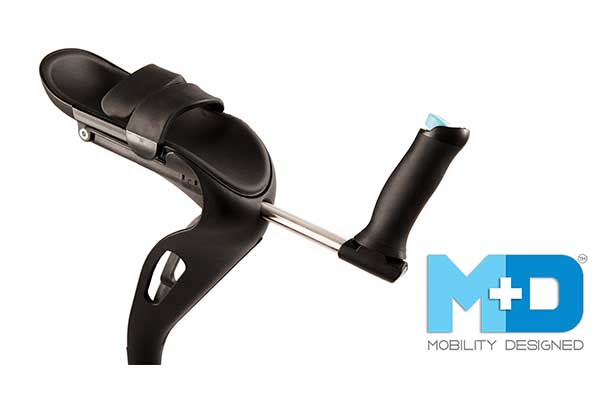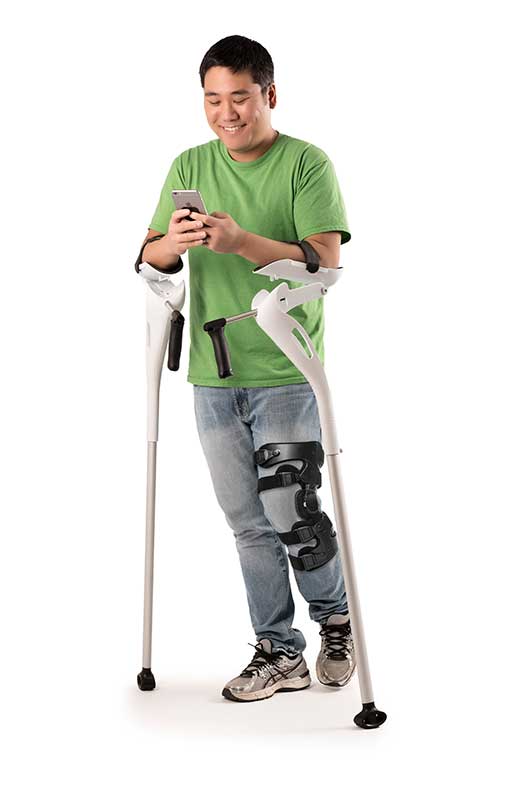Anyone who has ever used crutches knows they can be a real pain. In the armpits. In the wrists. In the forearms and elbows. In the shoulders.
This became a personal issue for Max Younger after his healthy father had knee surgery, contracted a staph infection and ended up having his leg amputated above the knee in August 2008. Max had just graduated with an industrial design degree from the Savannah College of Art & Design in Georgia, and in December that year married his college sweetheart, Liliana, who also earned a design degree from SCAD.
He saw his father on crutches constantly and was well aware of the discomfort they caused. It was then that Max decided to try to design a better crutch. The traditional, under-arm crutch technology, after all, has been around since the U.S. Civil War in the 1860s.
In a phone interview, Max recalled how he secured some studio space and started building prototype after prototype with materials from his garage and basement. “We got a 3D printer and started doing modeling,” he said.
Several years later, after the birth of their first child, Liliana told Max that she wanted to help him build a company to realize his dream. She took an entrepreneurship business program at the University of Missouri – Kansas City, and told Max that if he developed the product, she would run the company. And so, Mobility Designed LLC was born in 2015, with Liliana as co-founder and CEO. And their latest “baby” is the M+D Crutch.

(All photos courtesy of Mobility Designed LLC)
Though he was a business novice, Max did accrue some early manufacturing experience.
“When I was 14, I started working as an apprentice to a mold maker at a statuary company in Kansas City. For five years, during summers and breaks, I made molds – multipart molds, they’d have slides on them and the like. I learned about drafts and part lines and flashing. It was all the same principles as with steel tooling, but with fiberglass. Some of the molds were as big as me.”
As a designer, Younger believes in the maxim that “form follows function.” As a result, all elements of his M+D crutch are there for a reason, not just for style or aesthetics.
“We knew we didn’t want to use the armpits. We knew we didn’t want to use the hand rests to support weight. So, how else can we do it?” He estimates the ideation process involved going through 1,200 to 1,500 ideas, over several years. They looked at devices you sit on, or kneel on, and more, but through a “natural filtration” of design ideas, they gravitated to focusing weight placement on the elbows, which Younger says had not been done before.
Other crutches may describe themselves as elbow crutches, but they really use the forearm to support the weight, he said. Younger focused on creating support for the elbow. They needed some aspect of shock absorption. The final product’s upside-down question-mark shape helps to absorb some shock, and the rubber feet on the crutch also help in that regard.
“The feet were really an important material for us to get right. We test our feet here. We have machines that we engineered and built to test durability and friction – and our friction is about twice the standard of most crutch tips.”

That was great, but they also had to deal with wear — if it was too soft, it would wear prematurely; if it was too hard, it wouldn’t grip. And then there was the issue of how to deal with temperature differentiation, with how the tip material would react in both hot and cold environments. And how to deal with water, to avoid hydroplaning.
The typical plastic crutch foot is round, Younger noted, and when it hits a wet tile floor, for example, it easily can slip out from under, causing the user to fall.
“Our tips are designed not to do that,” he said. By using a tread pattern of various circles on the foot’s surface, the water is dispersed, which minimizes any hydroplaning. Each foot contains a thick piece of natural vulcanized rubber, with additives compounded in to help with abrasion resistance, and continued grip throughout the wear.
The rest of the elbow crutch also involved a number of key material decisions. It features an aluminum leg and a stainless steel handle tube. For the foam forearm pads, Younger and his team worked with a shoe insole company that works with Nike. The foam incorporates an antimicrobial additive (similar to a silver nanoparticle, but not quite as pricey), he said. But, still, the foam pad is quite an expensive component. It provides not only some shock absorption, but also provides good abrasion resistance, doesn’t slip and doesn’t sweat.

“Figuring out the foam was really a headache for me. Do you want hydrophobic or hydrophilic, open cell or closed cell? If you use hydrophobic, you get a pool of water; if you use hydrophilic, then it absorbs, and you get bacteria issues,” he explained.
They ended up using a fabric pattern on the surface that helps with friction and which allows the arm to naturally disperse the moisture.
The elbow crutch’s arms come in either black or white color, and are molded from glass-filled nylon in Taiwan, where their production tooling also was made. The design team did a lot of finite element analysis on these parts during development to test strength, flexibility and breakage limits. That resulted in them adding much more ribbing to prevent unwanted bending.
“We learned in our testing that we needed to have a cradle that raised up. The hinged cradle allows you to raise your hand up to your face, to talk on the phone, or brush your teeth, etc.”

One of the bigger challenges for us was the armbands — both in terms of materials and in transferring into production.
“The glass-filled nylon clips that we’d CNC [computer numerical control – a cutting machine with a router] would hold up fairly well in our tests, but in our first production runs, we had to replace most of those armbands because they would pop off.”
The armbands endure a lot of stresses — impact stresses and the stress of arms being taken in and out repeatedly. A texture on the bands reduces sweating, and helps to facilitate the in-and-out motion by minimizing contact with skin or clothing.
“We engineered and built a machine to test both the tensile strength and the shear of the armbands. We literally pulled them apart until they would tear.”
Getting the durometer exactly right on the flexible bands was a challenge. The team began by using an ethylene-vinyl acetate (EVA) resin for the armbands (like that used in mouth guards). But when they switched to nylon for more durable clips, they had to abandon the EVA since it doesn’t bond to nylon. They ended up using an undisclosed thermoplastic rubber for the armbands.
Shrink rates of materials also proved to be a problem – at least for a design student who was a neophyte embarking on a manufacturing project. He learned the hard way you couldn’t just swap out one material for another.
Like many entrepreneurs, Younger also learned that designing a good product is perhaps only 10 percent of what’s involved in creating a successful company.
“Back then,” Younger admits, “I knew design really well, but I didn’t know marketing.”
In mid-2016 a video of the M+D Crutch went viral, and it altered the arc of the company, which had to begin thinking globally a lot sooner than had been planned.
“We didn’t even have a website that could take orders at that time,” Max said, and so they had to build an e-commerce-ready website over the weekend.
They sold out their first two modest production runs before they had manufactured a single product, and shipped their first crutches in January 2017. Mobility Designed now holds three design patents, and has three pending utility patents, along with foreign filings in several countries, he said.
Younger said Mobility Designed is busy working on future versions of the product. For instance, they have received a lot of enquiries for crutches to fit young children (6 to 8 years old), and so have been developing a scaled-down version. There also is demand for a number of accessories, such as different feet attachments (e.g., an ice foot, a beach foot, etc.).
The firm, meanwhile, is touting its product’s performance, based on a user survey it conducted last summer. It claims that 71 percent of M+D Crutch users reported that they “do not hurt at all” in their hands/wrists when using the product compared to only 15 percent reporting the same result with other crutches (including both traditional and forearm crutches). M+D Crutch users also reported a decrease in pain in the forearm/elbow and the shoulders compared to that with other crutches.
Last summer, Liliana stepped aside as the firm’s start-up CEO (while remaining on the board), in favor of an experienced executive, Dan Alcazar, whose role is to serve as a growth catalyst.
It appears to be working. M+D Crutches cost $250 a pair; single crutches – billed as a “cane alternative” – are priced at $125 each. The firm is selling product now in the U.S., Canada, Mexico, United Kingdom, United Arab Emirates, Australia, Romania, Japan and several European Union countries, including Italy and Germany.
—–
See a brief promo video of M+D Crutch in action at http://bit.ly/MDCrutch_video or a June 2017 Kansas City television interview with Max and Liliana at http://bit.ly/KCL_interview.
Did you know you can use Prospector® to search for medical plastics?
The Unlimited subscription plan gives you access to specialty material filters for 3D printing materials, biopolymers, medical plastics, and more.
Subscribe today!
The views, opinions and technical analyses presented here are those of the author or advertiser, and are not necessarily those of ULProspector.com or UL Solutions. The appearance of this content in the UL Prospector Knowledge Center does not constitute an endorsement by UL Solutions or its affiliates.
All content is subject to copyright and may not be reproduced without prior authorization from UL Solutions or the content author.
The content has been made available for informational and educational purposes only. While the editors of this site may verify the accuracy of its content from time to time, we assume no responsibility for errors made by the author, editorial staff or any other contributor.
UL Solutions does not make any representations or warranties with respect to the accuracy, applicability, fitness or completeness of the content. UL Solutions does not warrant the performance, effectiveness or applicability of sites listed or linked to in any content.


